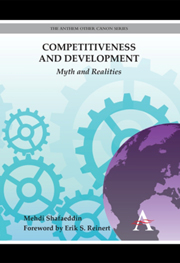Book contents
- Frontmatter
- Contents
- List of Tables, Figures and Boxes
- Foreword
- Preface
- Acknowledgements
- List of Abbreviations
- 1 Introduction: Framework of Analysis
- 2 Context and Conditions of International Competition
- 3 Alternative Theories of Competitiveness
- 4 Firm Strategy and New Industrial Organization
- 5 External Economies: Organization of Interfirm Relations
- 6 Reputation and Trust: A Firm's Relations with Stakeholders and Others
- 7 Innovation and Upgrading
- 8 Government Policies
- 9 The Experiences of China and Mexico
- 10 Summary and Concluding Remarks
- Appendices
- Bibliography
- Index
3 - Alternative Theories of Competitiveness
Published online by Cambridge University Press: 05 February 2013
- Frontmatter
- Contents
- List of Tables, Figures and Boxes
- Foreword
- Preface
- Acknowledgements
- List of Abbreviations
- 1 Introduction: Framework of Analysis
- 2 Context and Conditions of International Competition
- 3 Alternative Theories of Competitiveness
- 4 Firm Strategy and New Industrial Organization
- 5 External Economies: Organization of Interfirm Relations
- 6 Reputation and Trust: A Firm's Relations with Stakeholders and Others
- 7 Innovation and Upgrading
- 8 Government Policies
- 9 The Experiences of China and Mexico
- 10 Summary and Concluding Remarks
- Appendices
- Bibliography
- Index
Summary
…the objective [of a given nation] is not to increase directly, by means of commercial restrictions, the sum of exchangeable values in a country, but its productive power.
(List 1856, 253)Introduction
Some attempts have been made during recent decades to develop alternative theories of competitiveness for the theory of static comparative advantage. The common features of these theories consist of two main issues: the distinction between static and dynamic considerations, and envisaging an important role for ‘nonprice/cost’ vis-à-vis cost factors. Most of these theories are developed in the context of developed countries where established firms operate. Capability-building theory is the only exception. Nevertheless, as developing country firms ought to compete with established firms and would like to join them eventually, it is necessary to review those theories as well.
Before proceeding further, let us emphasize that our extensive discussion of the nonprice/cost factors is by no means the denial of the importance of price and cost for a given product quality in competitiveness. In fact it has been shown, for example, that each 10 per cent cost reduction by a US manufacturing firm would increase its market share by 2 per cent (Eckward 1992). In a similar study of 14 developed countries Carlin et al. (2001) have shown that while the sensitivity of export market shares to RULC varies from one country to another, on average every 10 per cent reduction in relative costs leads to a 2.7 per cent increase in export market shares.
- Type
- Chapter
- Information
- Competitiveness and DevelopmentMyth and Realities, pp. 49 - 78Publisher: Anthem PressPrint publication year: 2012



